Nursing Report: Analyzing Stimulants' Effects on Student Performance
VerifiedAdded on 2020/05/03
|10
|2462
|48
Report
AI Summary
This report critically analyzes two peer-reviewed articles related to the PICO question: "Do stimulants increase academic performance in university students?" The first article, by Hildt et al. (2014), employed a qualitative approach to explore the life context of stimulant use, while the second, by Munro et al. (2017), used a quantitative method to assess the relationship between nonmedical stimulant use, executive functioning, and academic outcomes. The report examines the authorship, research aims, design, findings, strengths, and weaknesses of each study. It also highlights barriers to applying the research in practice, particularly for a student considering stimulant use. The analysis reveals that while the studies indicate an association between stimulant use and academic performance, they do not establish a causal effect or a consistent positive impact on academic outcomes. The report concludes that further research is needed to determine the relationship between stimulant use, cognitive function, and academic performance and the need for longitudinal studies with larger populations and reliable data sources.
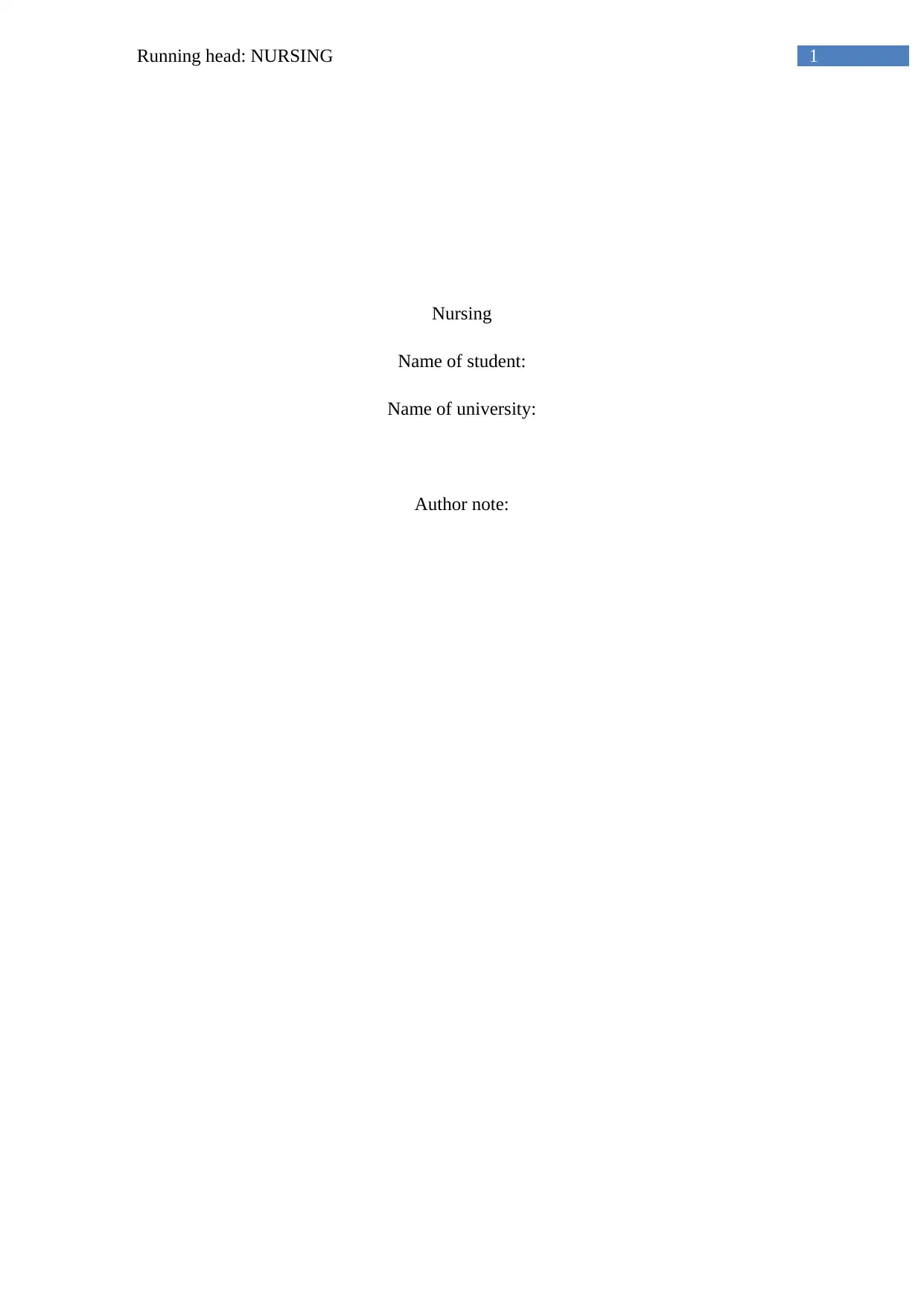
1Running head: NURSING
Nursing
Name of student:
Name of university:
Author note:
Nursing
Name of student:
Name of university:
Author note:
Paraphrase This Document
Need a fresh take? Get an instant paraphrase of this document with our AI Paraphraser
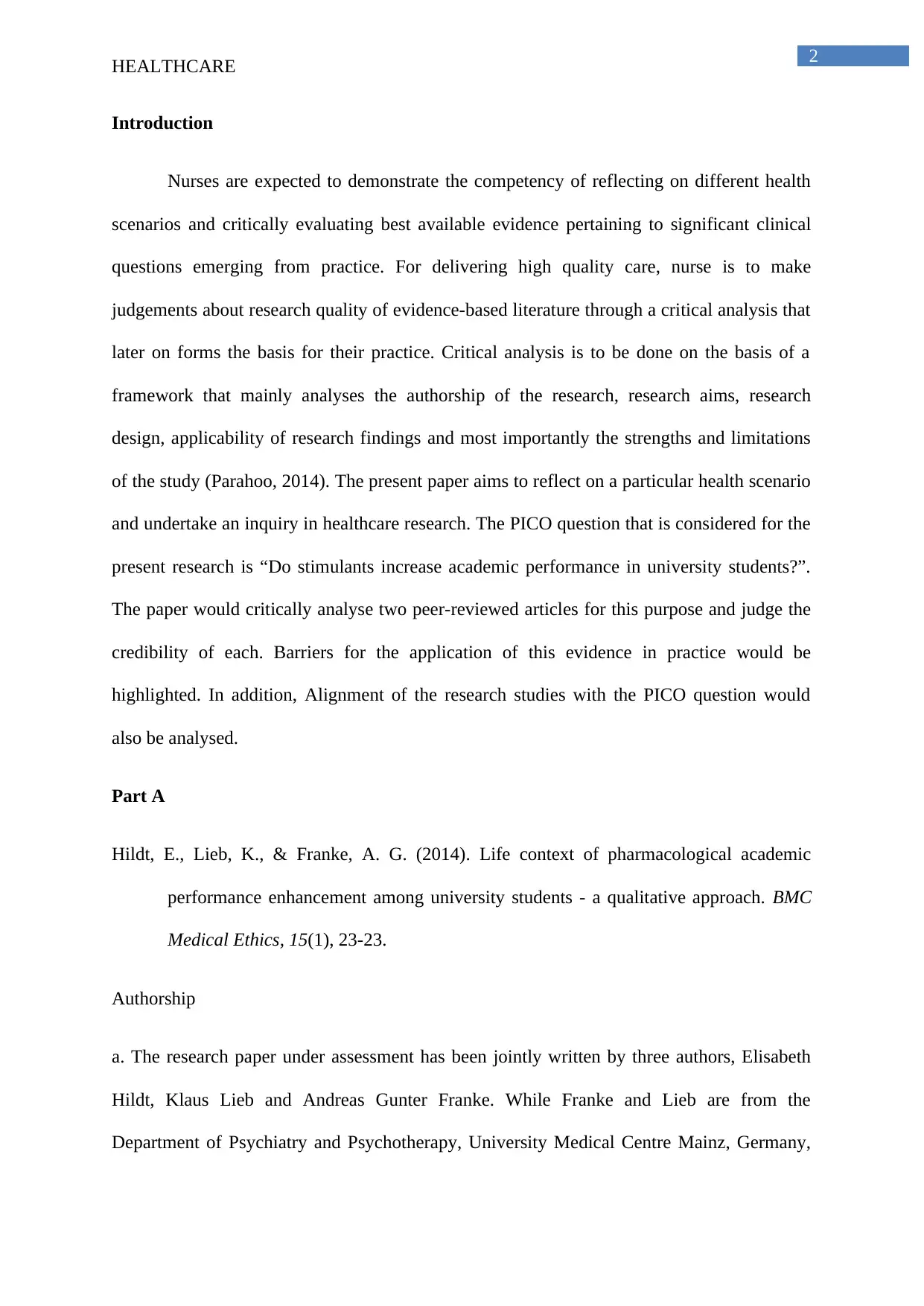
2
HEALTHCARE
Introduction
Nurses are expected to demonstrate the competency of reflecting on different health
scenarios and critically evaluating best available evidence pertaining to significant clinical
questions emerging from practice. For delivering high quality care, nurse is to make
judgements about research quality of evidence-based literature through a critical analysis that
later on forms the basis for their practice. Critical analysis is to be done on the basis of a
framework that mainly analyses the authorship of the research, research aims, research
design, applicability of research findings and most importantly the strengths and limitations
of the study (Parahoo, 2014). The present paper aims to reflect on a particular health scenario
and undertake an inquiry in healthcare research. The PICO question that is considered for the
present research is “Do stimulants increase academic performance in university students?”.
The paper would critically analyse two peer-reviewed articles for this purpose and judge the
credibility of each. Barriers for the application of this evidence in practice would be
highlighted. In addition, Alignment of the research studies with the PICO question would
also be analysed.
Part A
Hildt, E., Lieb, K., & Franke, A. G. (2014). Life context of pharmacological academic
performance enhancement among university students - a qualitative approach. BMC
Medical Ethics, 15(1), 23-23.
Authorship
a. The research paper under assessment has been jointly written by three authors, Elisabeth
Hildt, Klaus Lieb and Andreas Gunter Franke. While Franke and Lieb are from the
Department of Psychiatry and Psychotherapy, University Medical Centre Mainz, Germany,
HEALTHCARE
Introduction
Nurses are expected to demonstrate the competency of reflecting on different health
scenarios and critically evaluating best available evidence pertaining to significant clinical
questions emerging from practice. For delivering high quality care, nurse is to make
judgements about research quality of evidence-based literature through a critical analysis that
later on forms the basis for their practice. Critical analysis is to be done on the basis of a
framework that mainly analyses the authorship of the research, research aims, research
design, applicability of research findings and most importantly the strengths and limitations
of the study (Parahoo, 2014). The present paper aims to reflect on a particular health scenario
and undertake an inquiry in healthcare research. The PICO question that is considered for the
present research is “Do stimulants increase academic performance in university students?”.
The paper would critically analyse two peer-reviewed articles for this purpose and judge the
credibility of each. Barriers for the application of this evidence in practice would be
highlighted. In addition, Alignment of the research studies with the PICO question would
also be analysed.
Part A
Hildt, E., Lieb, K., & Franke, A. G. (2014). Life context of pharmacological academic
performance enhancement among university students - a qualitative approach. BMC
Medical Ethics, 15(1), 23-23.
Authorship
a. The research paper under assessment has been jointly written by three authors, Elisabeth
Hildt, Klaus Lieb and Andreas Gunter Franke. While Franke and Lieb are from the
Department of Psychiatry and Psychotherapy, University Medical Centre Mainz, Germany,
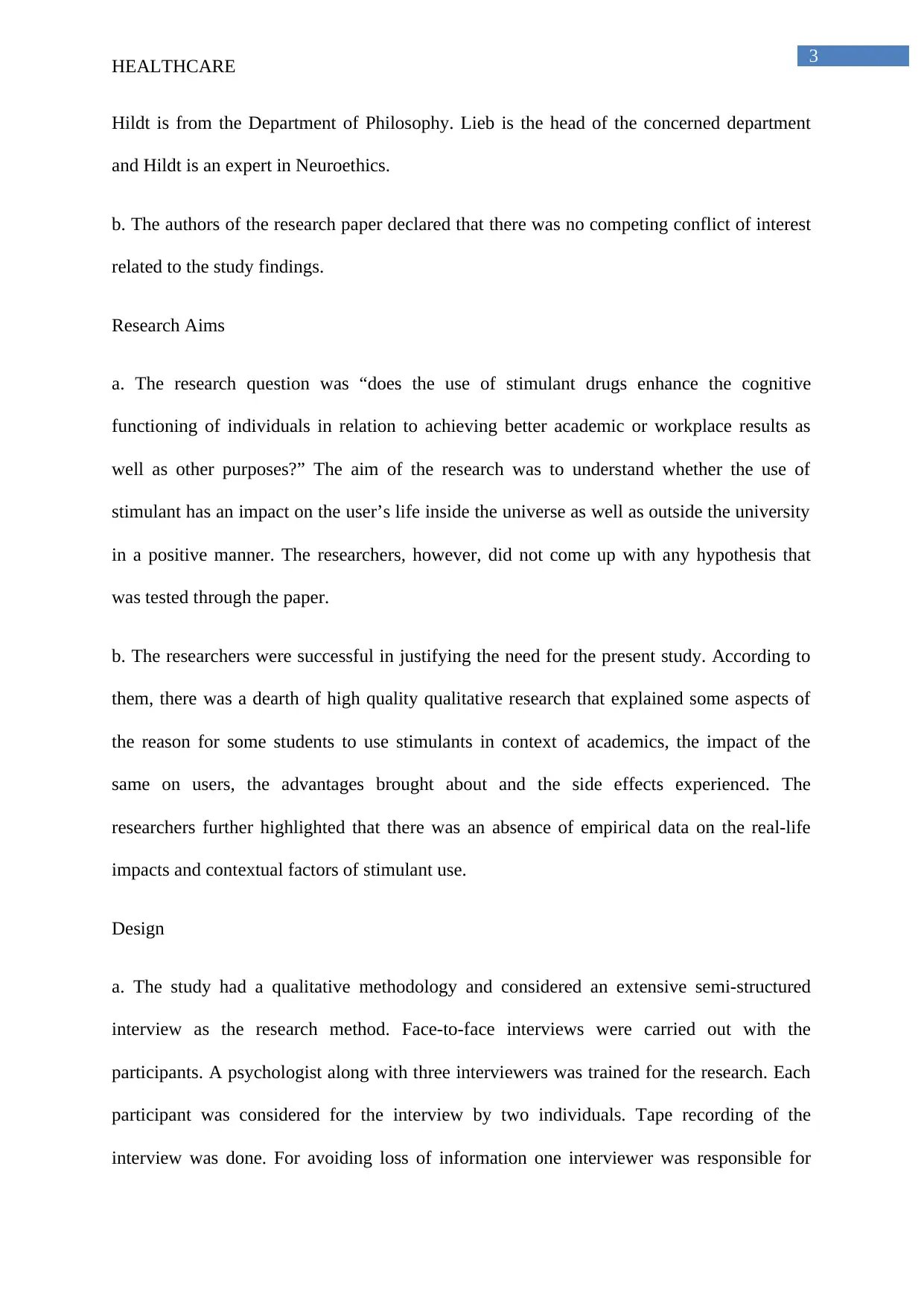
3
HEALTHCARE
Hildt is from the Department of Philosophy. Lieb is the head of the concerned department
and Hildt is an expert in Neuroethics.
b. The authors of the research paper declared that there was no competing conflict of interest
related to the study findings.
Research Aims
a. The research question was “does the use of stimulant drugs enhance the cognitive
functioning of individuals in relation to achieving better academic or workplace results as
well as other purposes?” The aim of the research was to understand whether the use of
stimulant has an impact on the user’s life inside the universe as well as outside the university
in a positive manner. The researchers, however, did not come up with any hypothesis that
was tested through the paper.
b. The researchers were successful in justifying the need for the present study. According to
them, there was a dearth of high quality qualitative research that explained some aspects of
the reason for some students to use stimulants in context of academics, the impact of the
same on users, the advantages brought about and the side effects experienced. The
researchers further highlighted that there was an absence of empirical data on the real-life
impacts and contextual factors of stimulant use.
Design
a. The study had a qualitative methodology and considered an extensive semi-structured
interview as the research method. Face-to-face interviews were carried out with the
participants. A psychologist along with three interviewers was trained for the research. Each
participant was considered for the interview by two individuals. Tape recording of the
interview was done. For avoiding loss of information one interviewer was responsible for
HEALTHCARE
Hildt is from the Department of Philosophy. Lieb is the head of the concerned department
and Hildt is an expert in Neuroethics.
b. The authors of the research paper declared that there was no competing conflict of interest
related to the study findings.
Research Aims
a. The research question was “does the use of stimulant drugs enhance the cognitive
functioning of individuals in relation to achieving better academic or workplace results as
well as other purposes?” The aim of the research was to understand whether the use of
stimulant has an impact on the user’s life inside the universe as well as outside the university
in a positive manner. The researchers, however, did not come up with any hypothesis that
was tested through the paper.
b. The researchers were successful in justifying the need for the present study. According to
them, there was a dearth of high quality qualitative research that explained some aspects of
the reason for some students to use stimulants in context of academics, the impact of the
same on users, the advantages brought about and the side effects experienced. The
researchers further highlighted that there was an absence of empirical data on the real-life
impacts and contextual factors of stimulant use.
Design
a. The study had a qualitative methodology and considered an extensive semi-structured
interview as the research method. Face-to-face interviews were carried out with the
participants. A psychologist along with three interviewers was trained for the research. Each
participant was considered for the interview by two individuals. Tape recording of the
interview was done. For avoiding loss of information one interviewer was responsible for
⊘ This is a preview!⊘
Do you want full access?
Subscribe today to unlock all pages.

Trusted by 1+ million students worldwide
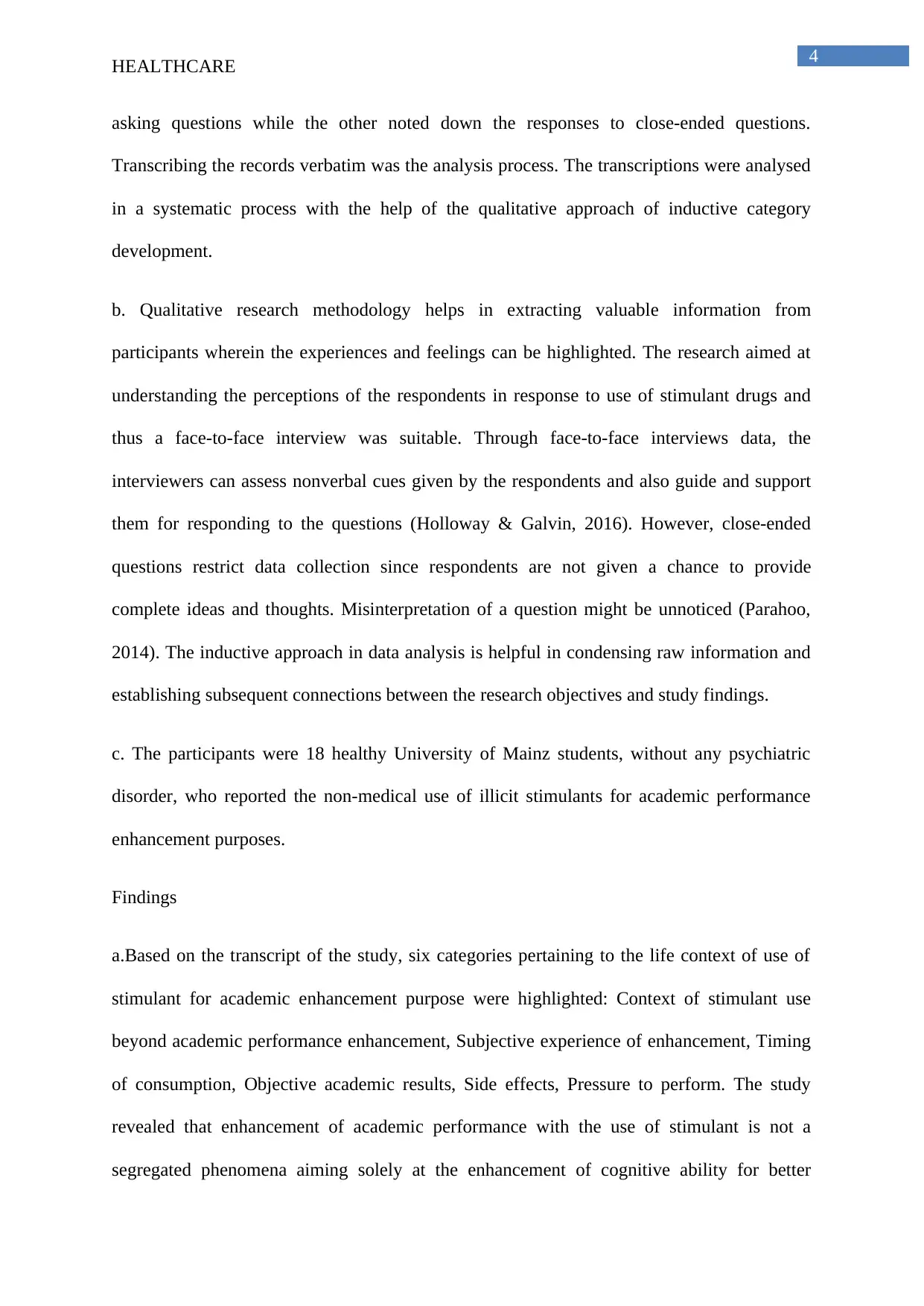
4
HEALTHCARE
asking questions while the other noted down the responses to close-ended questions.
Transcribing the records verbatim was the analysis process. The transcriptions were analysed
in a systematic process with the help of the qualitative approach of inductive category
development.
b. Qualitative research methodology helps in extracting valuable information from
participants wherein the experiences and feelings can be highlighted. The research aimed at
understanding the perceptions of the respondents in response to use of stimulant drugs and
thus a face-to-face interview was suitable. Through face-to-face interviews data, the
interviewers can assess nonverbal cues given by the respondents and also guide and support
them for responding to the questions (Holloway & Galvin, 2016). However, close-ended
questions restrict data collection since respondents are not given a chance to provide
complete ideas and thoughts. Misinterpretation of a question might be unnoticed (Parahoo,
2014). The inductive approach in data analysis is helpful in condensing raw information and
establishing subsequent connections between the research objectives and study findings.
c. The participants were 18 healthy University of Mainz students, without any psychiatric
disorder, who reported the non-medical use of illicit stimulants for academic performance
enhancement purposes.
Findings
a.Based on the transcript of the study, six categories pertaining to the life context of use of
stimulant for academic enhancement purpose were highlighted: Context of stimulant use
beyond academic performance enhancement, Subjective experience of enhancement, Timing
of consumption, Objective academic results, Side effects, Pressure to perform. The study
revealed that enhancement of academic performance with the use of stimulant is not a
segregated phenomena aiming solely at the enhancement of cognitive ability for better
HEALTHCARE
asking questions while the other noted down the responses to close-ended questions.
Transcribing the records verbatim was the analysis process. The transcriptions were analysed
in a systematic process with the help of the qualitative approach of inductive category
development.
b. Qualitative research methodology helps in extracting valuable information from
participants wherein the experiences and feelings can be highlighted. The research aimed at
understanding the perceptions of the respondents in response to use of stimulant drugs and
thus a face-to-face interview was suitable. Through face-to-face interviews data, the
interviewers can assess nonverbal cues given by the respondents and also guide and support
them for responding to the questions (Holloway & Galvin, 2016). However, close-ended
questions restrict data collection since respondents are not given a chance to provide
complete ideas and thoughts. Misinterpretation of a question might be unnoticed (Parahoo,
2014). The inductive approach in data analysis is helpful in condensing raw information and
establishing subsequent connections between the research objectives and study findings.
c. The participants were 18 healthy University of Mainz students, without any psychiatric
disorder, who reported the non-medical use of illicit stimulants for academic performance
enhancement purposes.
Findings
a.Based on the transcript of the study, six categories pertaining to the life context of use of
stimulant for academic enhancement purpose were highlighted: Context of stimulant use
beyond academic performance enhancement, Subjective experience of enhancement, Timing
of consumption, Objective academic results, Side effects, Pressure to perform. The study
revealed that enhancement of academic performance with the use of stimulant is not a
segregated phenomena aiming solely at the enhancement of cognitive ability for better
Paraphrase This Document
Need a fresh take? Get an instant paraphrase of this document with our AI Paraphraser
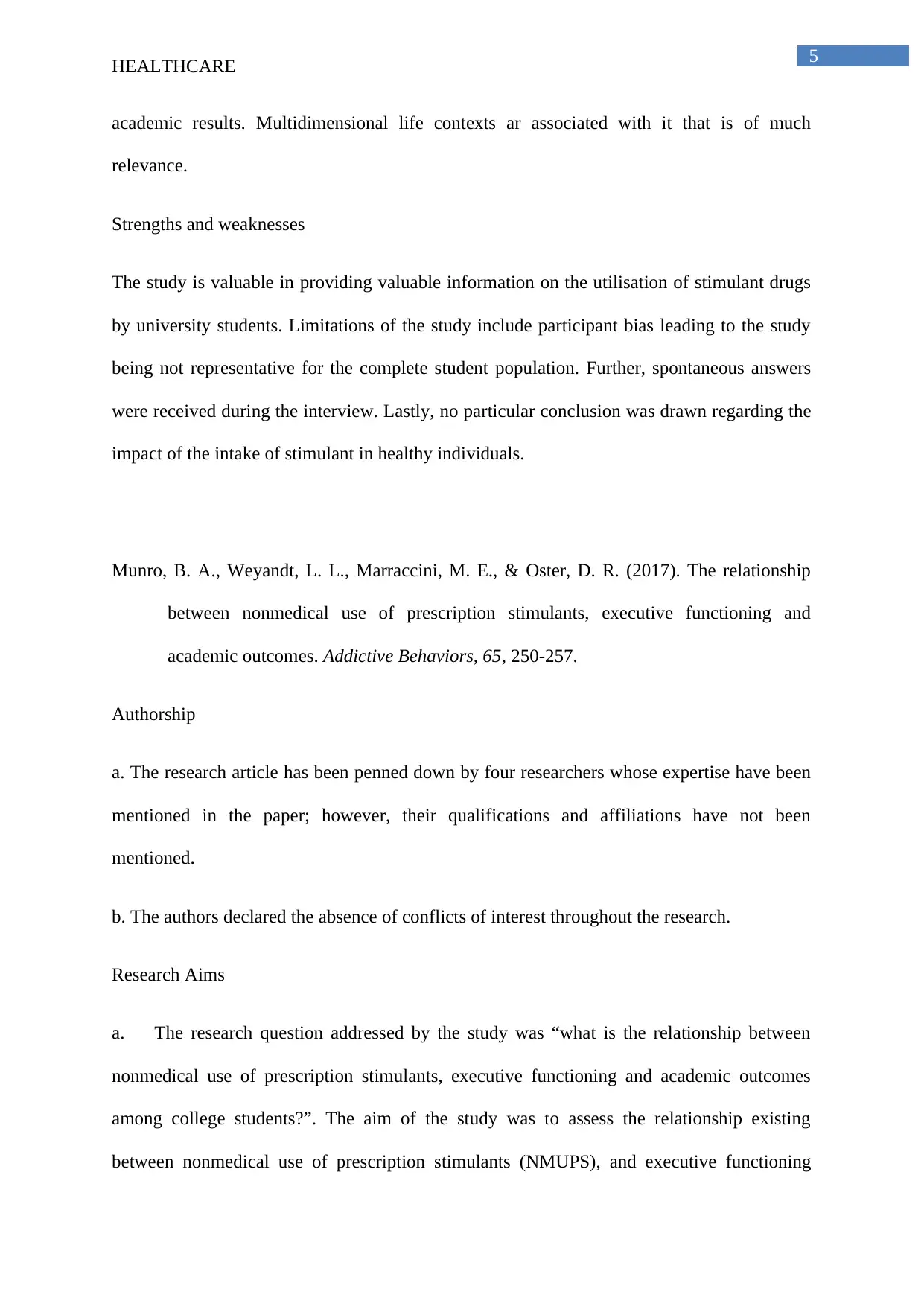
5
HEALTHCARE
academic results. Multidimensional life contexts ar associated with it that is of much
relevance.
Strengths and weaknesses
The study is valuable in providing valuable information on the utilisation of stimulant drugs
by university students. Limitations of the study include participant bias leading to the study
being not representative for the complete student population. Further, spontaneous answers
were received during the interview. Lastly, no particular conclusion was drawn regarding the
impact of the intake of stimulant in healthy individuals.
Munro, B. A., Weyandt, L. L., Marraccini, M. E., & Oster, D. R. (2017). The relationship
between nonmedical use of prescription stimulants, executive functioning and
academic outcomes. Addictive Behaviors, 65, 250-257.
Authorship
a. The research article has been penned down by four researchers whose expertise have been
mentioned in the paper; however, their qualifications and affiliations have not been
mentioned.
b. The authors declared the absence of conflicts of interest throughout the research.
Research Aims
a. The research question addressed by the study was “what is the relationship between
nonmedical use of prescription stimulants, executive functioning and academic outcomes
among college students?”. The aim of the study was to assess the relationship existing
between nonmedical use of prescription stimulants (NMUPS), and executive functioning
HEALTHCARE
academic results. Multidimensional life contexts ar associated with it that is of much
relevance.
Strengths and weaknesses
The study is valuable in providing valuable information on the utilisation of stimulant drugs
by university students. Limitations of the study include participant bias leading to the study
being not representative for the complete student population. Further, spontaneous answers
were received during the interview. Lastly, no particular conclusion was drawn regarding the
impact of the intake of stimulant in healthy individuals.
Munro, B. A., Weyandt, L. L., Marraccini, M. E., & Oster, D. R. (2017). The relationship
between nonmedical use of prescription stimulants, executive functioning and
academic outcomes. Addictive Behaviors, 65, 250-257.
Authorship
a. The research article has been penned down by four researchers whose expertise have been
mentioned in the paper; however, their qualifications and affiliations have not been
mentioned.
b. The authors declared the absence of conflicts of interest throughout the research.
Research Aims
a. The research question addressed by the study was “what is the relationship between
nonmedical use of prescription stimulants, executive functioning and academic outcomes
among college students?”. The aim of the study was to assess the relationship existing
between nonmedical use of prescription stimulants (NMUPS), and executive functioning

6
HEALTHCARE
(EF) and academic outcomes among a population of college students from five different
regions of the United States. The two hypothesis for the study were as follows-
Students reporting deficits in EF when measured with the Barkley Deficits Executive
Functioning Scale (BDEFS) show more chances of reporting nonmedical use of
prescription stimulants in contrast to students reporting average EF skills.
NMUPS alters the association between academic performance and EF in a positive
manner.
b. The researchers highlighted that previous research had pointed out the relationship
between individuals with EF deficiencies and intake of prescription stimulants. Research was
also present that indicated that a considerable proportion of college students in the US were
nonmedically using prescription stimulants. However, there was no significant study that
considered carrying out an investigation of the association between NMUPS and EF among
the college student population.
Design
a. The research considered a quantitative research methodology wherein three measures were
addressed. These were the Stimulant Survey Questionnaire (SSQ), Barkley Deficits in
Executive Functioning Scale (BDEFS for Adults) and Grade Point Average (GPA). Each
participant was required to complete a demographics questionnaire in addition to it.
Descriptive statistics were used for data analysis. For testing the first hypothesis, an
independent samples t-test was carried out which had one dichotomous independent variable
and one continuous dependent variable. For testing the second hypothesis, the researchers
conducted ANOVA test in which two dichotomous independent variables were included
along with one continuous dependent variable. For measuring effect size, Cohen’s ‘d’ was
used.
HEALTHCARE
(EF) and academic outcomes among a population of college students from five different
regions of the United States. The two hypothesis for the study were as follows-
Students reporting deficits in EF when measured with the Barkley Deficits Executive
Functioning Scale (BDEFS) show more chances of reporting nonmedical use of
prescription stimulants in contrast to students reporting average EF skills.
NMUPS alters the association between academic performance and EF in a positive
manner.
b. The researchers highlighted that previous research had pointed out the relationship
between individuals with EF deficiencies and intake of prescription stimulants. Research was
also present that indicated that a considerable proportion of college students in the US were
nonmedically using prescription stimulants. However, there was no significant study that
considered carrying out an investigation of the association between NMUPS and EF among
the college student population.
Design
a. The research considered a quantitative research methodology wherein three measures were
addressed. These were the Stimulant Survey Questionnaire (SSQ), Barkley Deficits in
Executive Functioning Scale (BDEFS for Adults) and Grade Point Average (GPA). Each
participant was required to complete a demographics questionnaire in addition to it.
Descriptive statistics were used for data analysis. For testing the first hypothesis, an
independent samples t-test was carried out which had one dichotomous independent variable
and one continuous dependent variable. For testing the second hypothesis, the researchers
conducted ANOVA test in which two dichotomous independent variables were included
along with one continuous dependent variable. For measuring effect size, Cohen’s ‘d’ was
used.
⊘ This is a preview!⊘
Do you want full access?
Subscribe today to unlock all pages.

Trusted by 1+ million students worldwide
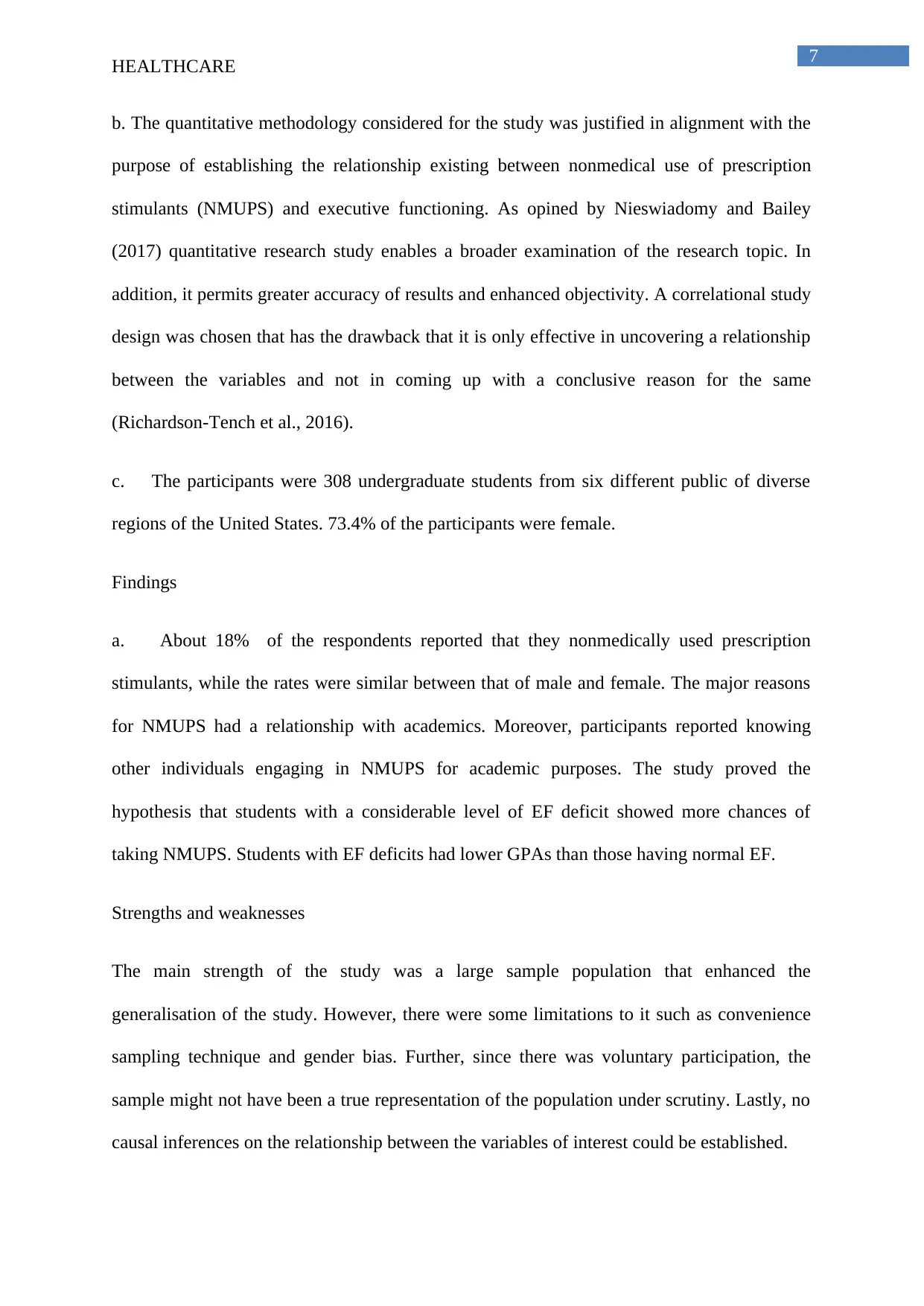
7
HEALTHCARE
b. The quantitative methodology considered for the study was justified in alignment with the
purpose of establishing the relationship existing between nonmedical use of prescription
stimulants (NMUPS) and executive functioning. As opined by Nieswiadomy and Bailey
(2017) quantitative research study enables a broader examination of the research topic. In
addition, it permits greater accuracy of results and enhanced objectivity. A correlational study
design was chosen that has the drawback that it is only effective in uncovering a relationship
between the variables and not in coming up with a conclusive reason for the same
(Richardson-Tench et al., 2016).
c. The participants were 308 undergraduate students from six different public of diverse
regions of the United States. 73.4% of the participants were female.
Findings
a. About 18% of the respondents reported that they nonmedically used prescription
stimulants, while the rates were similar between that of male and female. The major reasons
for NMUPS had a relationship with academics. Moreover, participants reported knowing
other individuals engaging in NMUPS for academic purposes. The study proved the
hypothesis that students with a considerable level of EF deficit showed more chances of
taking NMUPS. Students with EF deficits had lower GPAs than those having normal EF.
Strengths and weaknesses
The main strength of the study was a large sample population that enhanced the
generalisation of the study. However, there were some limitations to it such as convenience
sampling technique and gender bias. Further, since there was voluntary participation, the
sample might not have been a true representation of the population under scrutiny. Lastly, no
causal inferences on the relationship between the variables of interest could be established.
HEALTHCARE
b. The quantitative methodology considered for the study was justified in alignment with the
purpose of establishing the relationship existing between nonmedical use of prescription
stimulants (NMUPS) and executive functioning. As opined by Nieswiadomy and Bailey
(2017) quantitative research study enables a broader examination of the research topic. In
addition, it permits greater accuracy of results and enhanced objectivity. A correlational study
design was chosen that has the drawback that it is only effective in uncovering a relationship
between the variables and not in coming up with a conclusive reason for the same
(Richardson-Tench et al., 2016).
c. The participants were 308 undergraduate students from six different public of diverse
regions of the United States. 73.4% of the participants were female.
Findings
a. About 18% of the respondents reported that they nonmedically used prescription
stimulants, while the rates were similar between that of male and female. The major reasons
for NMUPS had a relationship with academics. Moreover, participants reported knowing
other individuals engaging in NMUPS for academic purposes. The study proved the
hypothesis that students with a considerable level of EF deficit showed more chances of
taking NMUPS. Students with EF deficits had lower GPAs than those having normal EF.
Strengths and weaknesses
The main strength of the study was a large sample population that enhanced the
generalisation of the study. However, there were some limitations to it such as convenience
sampling technique and gender bias. Further, since there was voluntary participation, the
sample might not have been a true representation of the population under scrutiny. Lastly, no
causal inferences on the relationship between the variables of interest could be established.
Paraphrase This Document
Need a fresh take? Get an instant paraphrase of this document with our AI Paraphraser
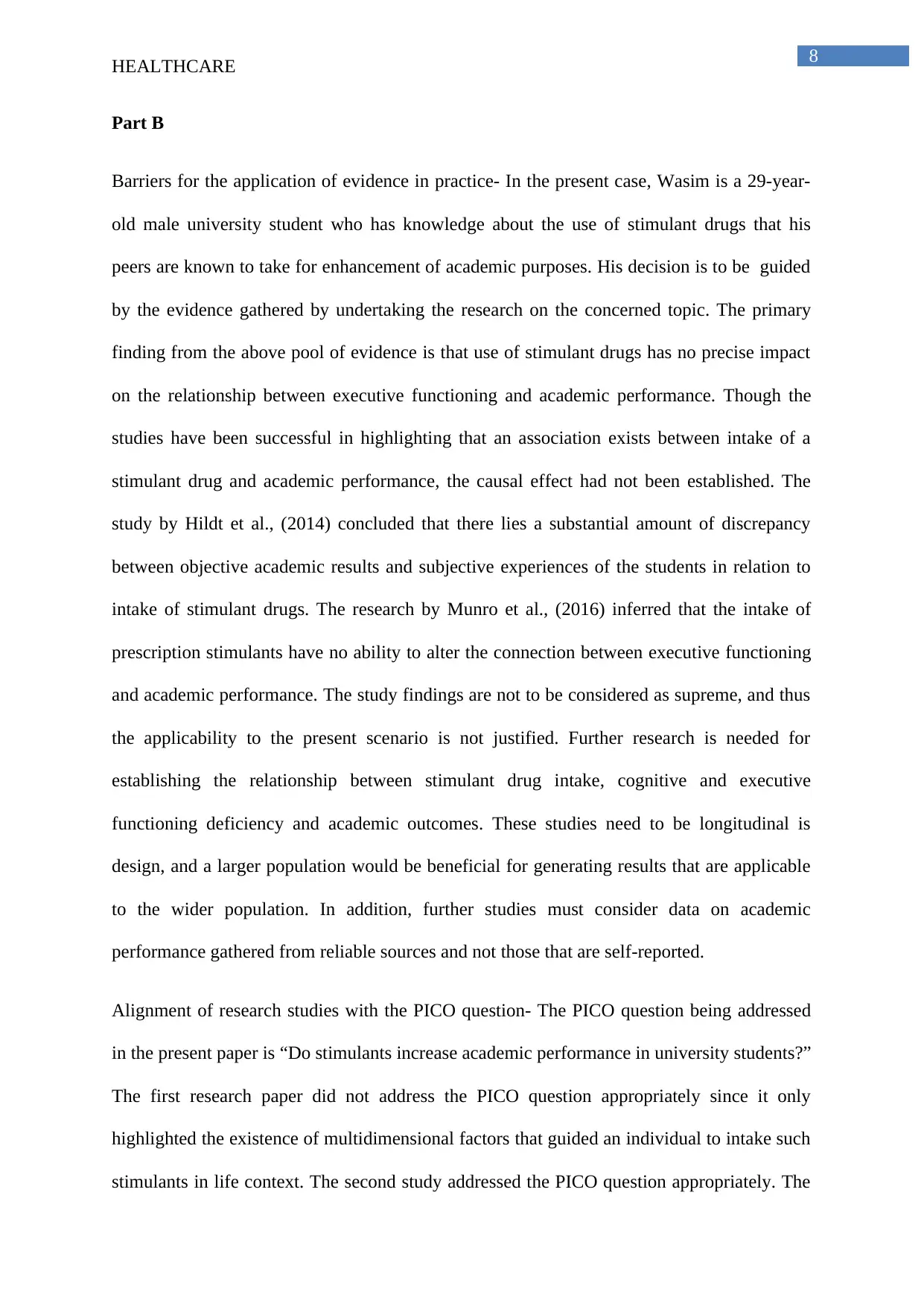
8
HEALTHCARE
Part B
Barriers for the application of evidence in practice- In the present case, Wasim is a 29-year-
old male university student who has knowledge about the use of stimulant drugs that his
peers are known to take for enhancement of academic purposes. His decision is to be guided
by the evidence gathered by undertaking the research on the concerned topic. The primary
finding from the above pool of evidence is that use of stimulant drugs has no precise impact
on the relationship between executive functioning and academic performance. Though the
studies have been successful in highlighting that an association exists between intake of a
stimulant drug and academic performance, the causal effect had not been established. The
study by Hildt et al., (2014) concluded that there lies a substantial amount of discrepancy
between objective academic results and subjective experiences of the students in relation to
intake of stimulant drugs. The research by Munro et al., (2016) inferred that the intake of
prescription stimulants have no ability to alter the connection between executive functioning
and academic performance. The study findings are not to be considered as supreme, and thus
the applicability to the present scenario is not justified. Further research is needed for
establishing the relationship between stimulant drug intake, cognitive and executive
functioning deficiency and academic outcomes. These studies need to be longitudinal is
design, and a larger population would be beneficial for generating results that are applicable
to the wider population. In addition, further studies must consider data on academic
performance gathered from reliable sources and not those that are self-reported.
Alignment of research studies with the PICO question- The PICO question being addressed
in the present paper is “Do stimulants increase academic performance in university students?”
The first research paper did not address the PICO question appropriately since it only
highlighted the existence of multidimensional factors that guided an individual to intake such
stimulants in life context. The second study addressed the PICO question appropriately. The
HEALTHCARE
Part B
Barriers for the application of evidence in practice- In the present case, Wasim is a 29-year-
old male university student who has knowledge about the use of stimulant drugs that his
peers are known to take for enhancement of academic purposes. His decision is to be guided
by the evidence gathered by undertaking the research on the concerned topic. The primary
finding from the above pool of evidence is that use of stimulant drugs has no precise impact
on the relationship between executive functioning and academic performance. Though the
studies have been successful in highlighting that an association exists between intake of a
stimulant drug and academic performance, the causal effect had not been established. The
study by Hildt et al., (2014) concluded that there lies a substantial amount of discrepancy
between objective academic results and subjective experiences of the students in relation to
intake of stimulant drugs. The research by Munro et al., (2016) inferred that the intake of
prescription stimulants have no ability to alter the connection between executive functioning
and academic performance. The study findings are not to be considered as supreme, and thus
the applicability to the present scenario is not justified. Further research is needed for
establishing the relationship between stimulant drug intake, cognitive and executive
functioning deficiency and academic outcomes. These studies need to be longitudinal is
design, and a larger population would be beneficial for generating results that are applicable
to the wider population. In addition, further studies must consider data on academic
performance gathered from reliable sources and not those that are self-reported.
Alignment of research studies with the PICO question- The PICO question being addressed
in the present paper is “Do stimulants increase academic performance in university students?”
The first research paper did not address the PICO question appropriately since it only
highlighted the existence of multidimensional factors that guided an individual to intake such
stimulants in life context. The second study addressed the PICO question appropriately. The
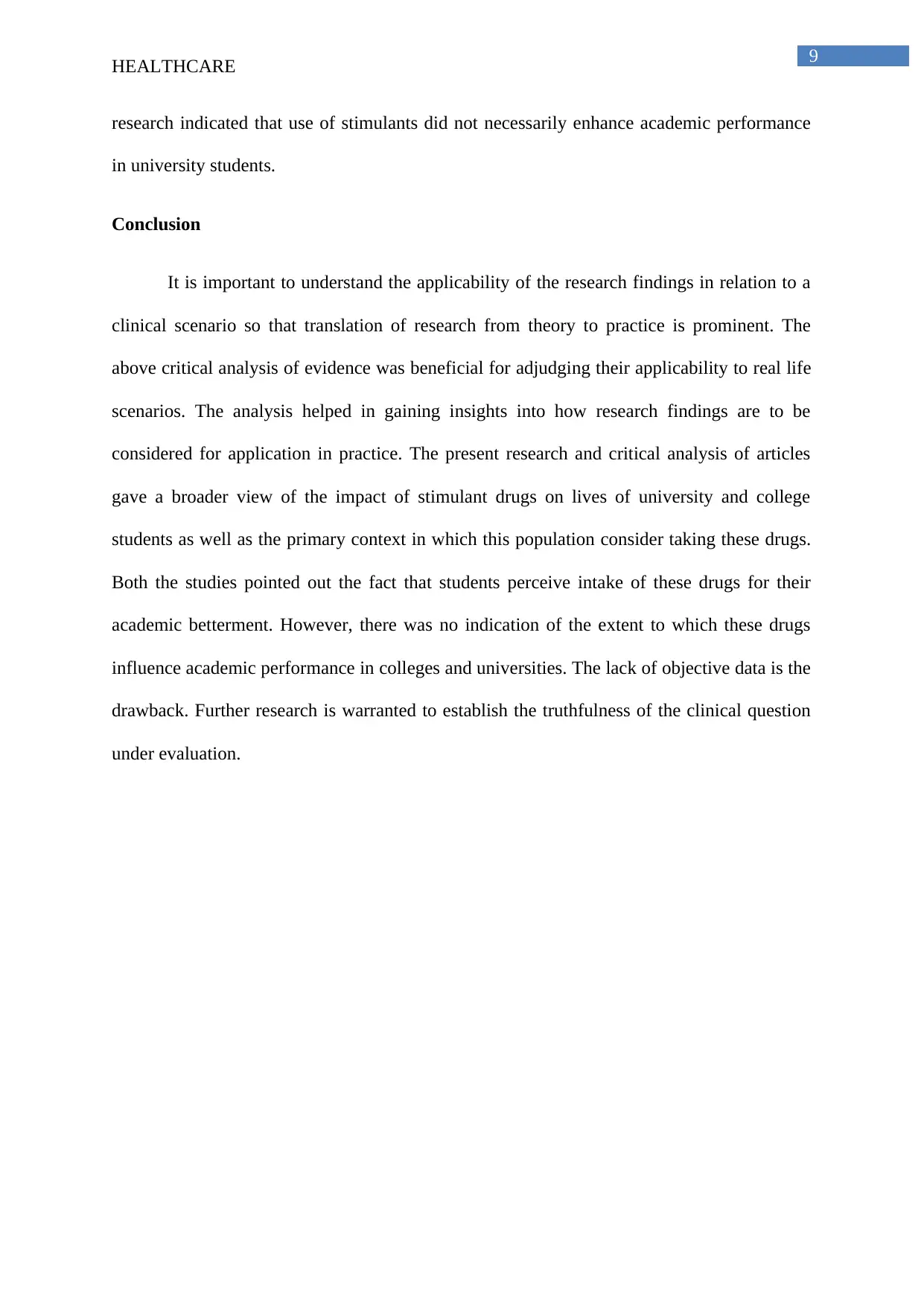
9
HEALTHCARE
research indicated that use of stimulants did not necessarily enhance academic performance
in university students.
Conclusion
It is important to understand the applicability of the research findings in relation to a
clinical scenario so that translation of research from theory to practice is prominent. The
above critical analysis of evidence was beneficial for adjudging their applicability to real life
scenarios. The analysis helped in gaining insights into how research findings are to be
considered for application in practice. The present research and critical analysis of articles
gave a broader view of the impact of stimulant drugs on lives of university and college
students as well as the primary context in which this population consider taking these drugs.
Both the studies pointed out the fact that students perceive intake of these drugs for their
academic betterment. However, there was no indication of the extent to which these drugs
influence academic performance in colleges and universities. The lack of objective data is the
drawback. Further research is warranted to establish the truthfulness of the clinical question
under evaluation.
HEALTHCARE
research indicated that use of stimulants did not necessarily enhance academic performance
in university students.
Conclusion
It is important to understand the applicability of the research findings in relation to a
clinical scenario so that translation of research from theory to practice is prominent. The
above critical analysis of evidence was beneficial for adjudging their applicability to real life
scenarios. The analysis helped in gaining insights into how research findings are to be
considered for application in practice. The present research and critical analysis of articles
gave a broader view of the impact of stimulant drugs on lives of university and college
students as well as the primary context in which this population consider taking these drugs.
Both the studies pointed out the fact that students perceive intake of these drugs for their
academic betterment. However, there was no indication of the extent to which these drugs
influence academic performance in colleges and universities. The lack of objective data is the
drawback. Further research is warranted to establish the truthfulness of the clinical question
under evaluation.
⊘ This is a preview!⊘
Do you want full access?
Subscribe today to unlock all pages.

Trusted by 1+ million students worldwide
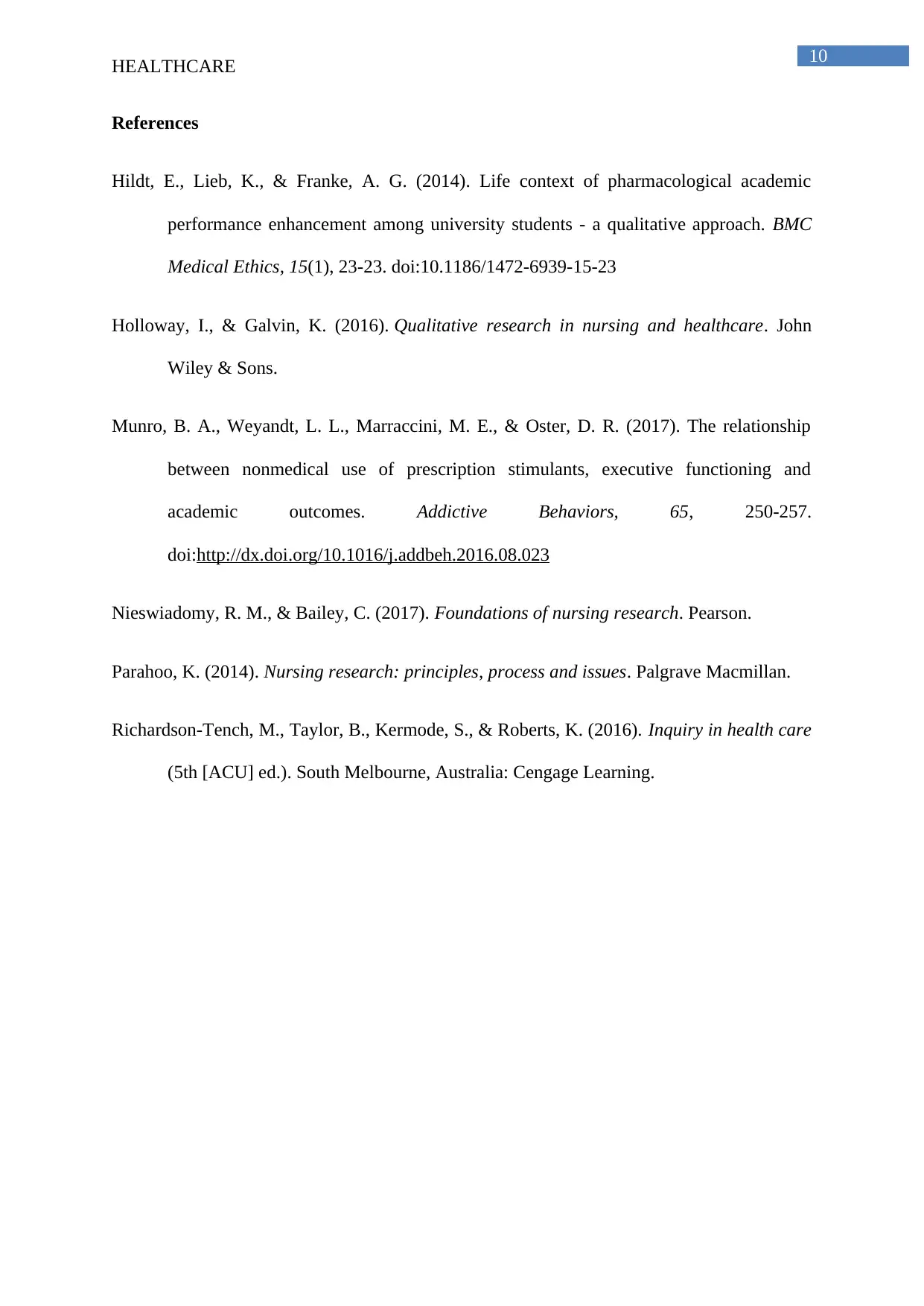
10
HEALTHCARE
References
Hildt, E., Lieb, K., & Franke, A. G. (2014). Life context of pharmacological academic
performance enhancement among university students - a qualitative approach. BMC
Medical Ethics, 15(1), 23-23. doi:10.1186/1472-6939-15-23
Holloway, I., & Galvin, K. (2016). Qualitative research in nursing and healthcare. John
Wiley & Sons.
Munro, B. A., Weyandt, L. L., Marraccini, M. E., & Oster, D. R. (2017). The relationship
between nonmedical use of prescription stimulants, executive functioning and
academic outcomes. Addictive Behaviors, 65, 250-257.
doi:http://dx.doi.org/10.1016/j.addbeh.2016.08.023
Nieswiadomy, R. M., & Bailey, C. (2017). Foundations of nursing research. Pearson.
Parahoo, K. (2014). Nursing research: principles, process and issues. Palgrave Macmillan.
Richardson-Tench, M., Taylor, B., Kermode, S., & Roberts, K. (2016). Inquiry in health care
(5th [ACU] ed.). South Melbourne, Australia: Cengage Learning.
HEALTHCARE
References
Hildt, E., Lieb, K., & Franke, A. G. (2014). Life context of pharmacological academic
performance enhancement among university students - a qualitative approach. BMC
Medical Ethics, 15(1), 23-23. doi:10.1186/1472-6939-15-23
Holloway, I., & Galvin, K. (2016). Qualitative research in nursing and healthcare. John
Wiley & Sons.
Munro, B. A., Weyandt, L. L., Marraccini, M. E., & Oster, D. R. (2017). The relationship
between nonmedical use of prescription stimulants, executive functioning and
academic outcomes. Addictive Behaviors, 65, 250-257.
doi:http://dx.doi.org/10.1016/j.addbeh.2016.08.023
Nieswiadomy, R. M., & Bailey, C. (2017). Foundations of nursing research. Pearson.
Parahoo, K. (2014). Nursing research: principles, process and issues. Palgrave Macmillan.
Richardson-Tench, M., Taylor, B., Kermode, S., & Roberts, K. (2016). Inquiry in health care
(5th [ACU] ed.). South Melbourne, Australia: Cengage Learning.
1 out of 10
Related Documents
Your All-in-One AI-Powered Toolkit for Academic Success.
+13062052269
info@desklib.com
Available 24*7 on WhatsApp / Email
![[object Object]](/_next/static/media/star-bottom.7253800d.svg)
Unlock your academic potential
Copyright © 2020–2025 A2Z Services. All Rights Reserved. Developed and managed by ZUCOL.





